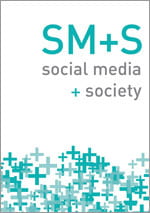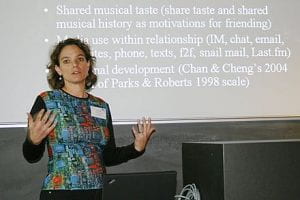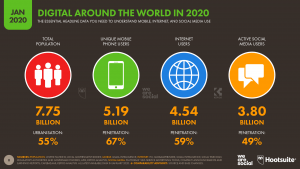


OLJ task 1 – Social Media and Society – Journal Article Analysis
When embarking on the CSU masters subject – Social Networking for Information Professionals, my reading journey has now delved into the influence that social media has on our current society as we know it. I have never really considered the impact of strategic communication and how the delivery of this has changed over time. Social media and networking has moulded and changed relationships and social and professional engagement and continues to do so.
Whilst listening to the podcast A Conversation with Nancy Baym, a Principal Researcher with Microsoft Research, it led me to consider how communications are always moving and growing, Baym described the shift towards online social platforms as ‘a real site of power renegotiation’. With this she goes on to elaborate that over the last 150 years, media and social networking has moved from the ‘elite’ controlled model, where popular culture entertainment platforms such as radio and television, was directed by a person or a group of people and presented to an audience in the same physical place at the same physical time. The introduction of the world wide web and social media platforms such as MySpace led to a more equitable culture of ‘access to media’. Here was a place where everyone could have a say, join communities, connect and advertise their businesses.
Baym continues to discuss that, as digital technologies have developed into the 21st century, people are finding themselves on social networking platforms either willingly or even at times unknowingly. Social media is affecting our everyday lives and changing the very definition of personal relationships. The example shared by Baym was Myspace. This platform provided the music industry with a fan based energy to connect audiences through social media. With this came marketing for brands, companies and professionals, in a place where a self-brand could be developed and remain lively and engaging for communities with similar interest.
Through social media platforms the music industry has predicted social change and effected crowd/fan engagement and therfore enabled the increase of sales and popularity. Baym also discusses the tensions and divide between the previous tightly controlled media networks to the current day equitable access to media where everyone can post, share and speak. This understandably comes with a myriad of positives and negative aspects.
When discussing the theory research of the constitution of social media Baym discussed;
- Material Labour – The actual communication
- Effective Labour – Non-verbal communication
- Information Labour – The real content of the communication
- Emotional Labour – Focused on the encounter
- Relational Labour – The relationship of the communicator and engager
These concepts I found to be quite interesting and in particular emotional labour which further readings led me to find that it is the ‘professional online engagement can be analysed in terms of ‘emotional labour’ (Hochschild 1983). It explores whether the pleasure that practitioners derive from online work, the freedom it gives them to work remotely and flexibly and the licence it offers to build a personal brand also serves to hide exploitation, legitimize long working hours and reaffirm existing gender roles’
However, with freedom and flexibility for work, I ask the question; How are our responsibilities impacted when considering target audiences, persuasion, engagement, balance between real life and virtual life? Baym discusses that the ethics of these kinds of relationships and labours and the ability to now create systems in order to have viable careers without personal connections, what works and what doesn’t work effectively? These need to be formed along with the consideration of the tensions that it raises, good and bad elements and our choices to engage in them or not.
For many of the issues raised in this podcast, I feel that this has developed many questions in my professional working mind as a Digital Technologies Leading Teacher, the many layers of ‘labour’ that make up social media environments all contribute to the end user experience and can be manipulated for ‘good or evil’. These all need to be considered when engaging in the use of social media and networking, as well as for when selecting and implementing the use of these networks for my own personal and professional purposes.
Finally Baym discusses that with social networks and the use of social media, this comes with cultures and expectations. With this topic being a generative topic and most relevant to digital native citizens, we all can make different and better choices now and shape a whole different world. The question that this raises for me is, Who is responsible for teaching future generations of the importance of appropriate culture, expectations and behaviour when engaging in and using social networking platforms?
References –
Lingel.J (2020) A Conversation with Nancy Baym, Author of Playing to the Crowd
Liz Bridgen (2011) Emotional labour and the pursuit of the personal brand: Public relations practitioners’ use of social media, Journal of Media Practice, 12:1, 61-76, DOI: 10.1386/jmpr.12.1.61_1
Sage Journals Volume 6 Issue 2, April-June 2020
Social Media and Society https://journals.sagepub.com/doi/full/10.1177/2056305119899008




